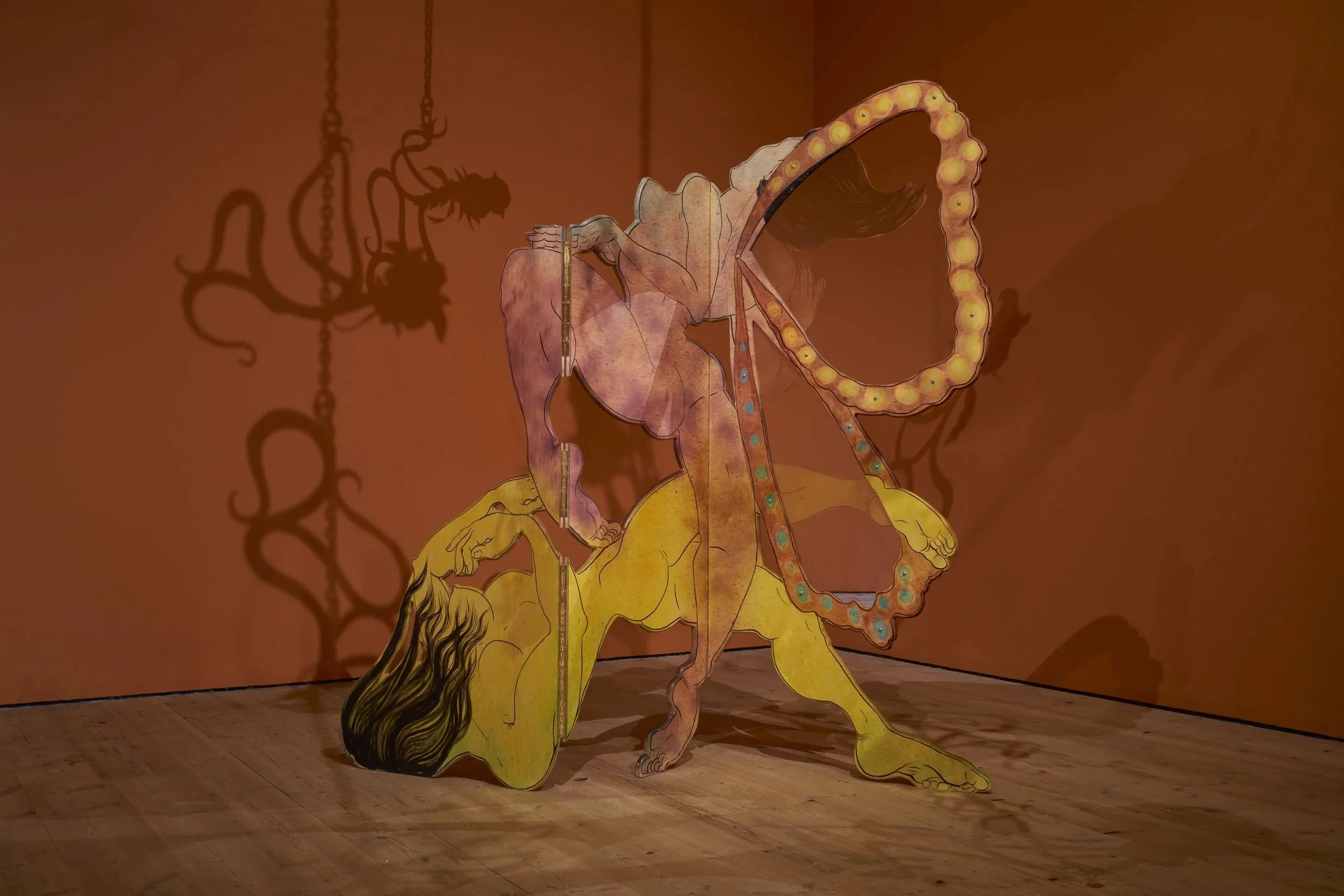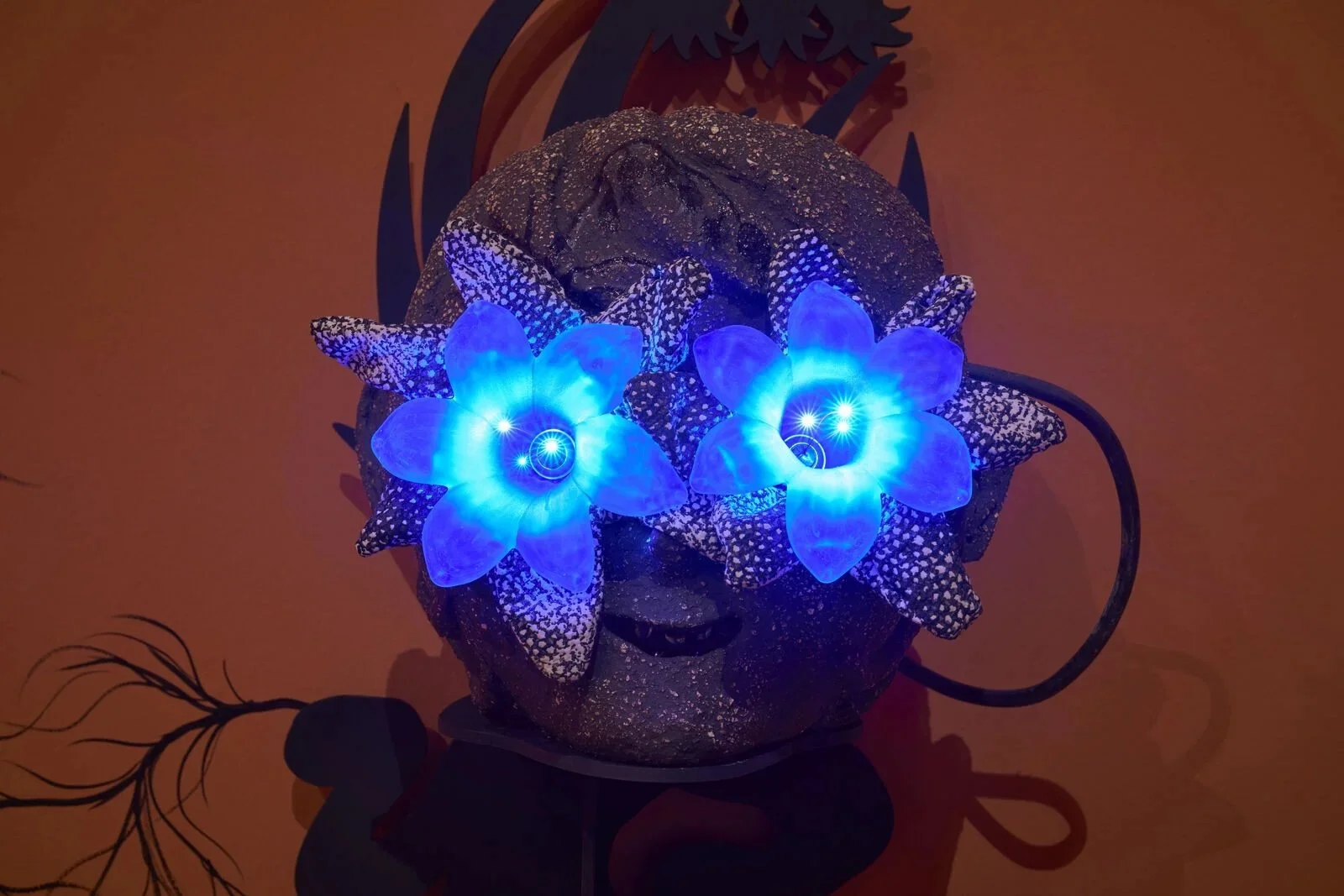Hot Coffee conversation with multidisciplinary London-based artist Saelia Aparicio
Published Tuesday, August 12, 2025
Saelia Aparicio is one of those rare artists who is inherently open to fluctuations and permeability. This current of visual experimentation, aiming to play with distorting our preconceived notions through some staged mystical rituals, is present in Aparicio’s large-scale sculptures, smaller anthropomorphic objects, wood stools, and site-specific murals. The artist uses personal symbolism, but also mythology, pop culture, eroticism, and non-binary representations as conduits of her visions. As a result, we see figures and faces open to new major shifts in thinking and living. This is a mimetic discourse on post-apocalyptic landscapes, biological adaptations, the destructive practices of late capitalism, and individual freedoms to choose the course of action. Aparicio’s practice is challenging to pin down (are the works sarcastic or joyful?) and dynamic. We did work on an exhibition in Berlin earlier this year, and I wanted to ask Saelia some questions about her current show at The Baltic Centre for Contemporary Art, UK titled “A Joyful Parasite.”
Nina: Imagine you are in your favorite coffee or tea spot. Where is it? What are you drinking? What are the three things you see right now?
Saelia Aparicio: I’m walking through Wanstead Flats in London, near where I live, drinking ginger and lemon from a thermal flask. I don’t enjoy sitting down for coffee on my own — I find it hard to stay still. During my walk, I have been listening to The Burnout Society by Byung-Chul Han. The three things I am looking at are my phone while I write this, an old oak tree, and a ragwort in full yellow bloom.
Installation view, Saelia Aparicio: A Joyful Parasite, 5 Jul 2025 – 1 Feb 2026, The Baltic Centre for Contemporary Art, UK.Image courtesy of the artist.
Nina: Please tell us more about 'A joyful parasite' at the Baltic Center in the UK. It is one of your major exhibitions to date. What are the major premises of this show?
SA: The show explores how we categorize and moralize living beings through an anthropocentric, capitalist lens, particularly in relation to land and territory. I focus on plants that symbolize national identity in the UK, many of which aren’t native, alongside so-called invasive weeds. At its core, the work centers on the hybrid: an intersectional figure that escapes easy classification. It celebrates transformation and adaptability, pushing back against the ideal of a static, bucolic nature—a vision I associate with exclusionary, right-wing fantasies. Instead, I propose a messier, wilder, more entangled idea of nature.
Installation view, Saelia Aparicio: A Joyful Parasite, 5 Jul 2025 – 1 Feb 2026, The Baltic Centre for Contemporary Art, UK. Image courtesy of the artist.
Nina: Aspects of hybridity and visual distortions are recurrent in your practice. Do you feel that these new commissioned works have brought new strands of your thinking to the viewers? Maybe you want to focus on one work and discuss it at length.
I hope so — they've definitely opened new lines of thought for me. The process of planning this exhibition was long and allowed me to expand a feminist strand of functional sculpture I’ve been exploring for a while.
One piece I’m particularly excited about is the flag installed at Newcastle Castle. It depicts an anthropomorphic Rhododendron ponticum in a confident, pin-up pose — exuberant, sexy, defiant. I chose this plant because it embodies a paradox. In the UK and Ireland, it’s listed as a top invasive species. Meanwhile, in its native Spain, it’s endangered due to climate change. To me, it symbolises forced migration, environmental displacement, and the will to thrive despite it all.
The flag’s background is black and white, echoing the Newcastle United colours, grounding it in local identity while questioning how belonging is constructed. I’m considering expanding this project further, creating flags or coats of arms for other displaced species, shaped by climate shifts or other manmade ecological changes.
Installation view, Saelia Aparicio: A Joyful Parasite, 5 Jul 2025 – 1 Feb 2026, The Baltic Centre for Contemporary Art, UK. Image courtesy of the artist and The Balti Centre.
Nina: Mythologies of Ancient Egypt and pre-Columbian Mesoamerica are of importance to you. When did this deep engagement begin? Do you have any specific methodology when working with these symbols, narratives, and characters?
SA: It’s not limited to those cultures—I’m drawn to ancient figures of power that appear across many traditions, especially when they take hybrid, surreal, or grotesque forms. I look for symbols that resist neat categorisation: anthropomorphic vessels, protective spirits, objects that are playful, strange, or even a bit obscene. Sheela na gigs, sonrientes from Veracruz, the Egyptian god Bes, or the Greek goddess Baubo are a few examples.
This fascination began in childhood. I’m from the north of Spain, where many churches feature grotesque carvings. My twin and I used to mimic them as a joke. That irreverence stayed with me. I gravitate toward figures of power that feel familiar, funny, even joyful—not the distant, serious archetypes we’re often taught to revere.
Installation view, Saelia Aparicio: A Joyful Parasite, 5 Jul 2025 – 1 Feb 2026, The Baltic Centre for Contemporary Art, UK. Image courtesy of the artist.
Nina: We have been discussing books in previous conversations. What is one book that has been most influential for you this year so far?
SA: I know it’s annoying, but I can’t pick just one. Dysphoria mundii by Paul B Preciado, Un lugar soleado para gente sombria by Mariana Enríquez, Feminismo Bastardo by Maria Galindo, Islands of Abandonment by Cal Flyn, and The Cute by Sianne Ngai have all shaped my thinking recently. Each one feeds into my work in different ways—whether through politics, aesthetics, or the emotional charge they carry.
Installation view, Saelia Aparicio: A Joyful Parasite, 5 Jul 2025 – 1 Feb 2026, The Baltic Centre for Contemporary Art, UK. Image courtesy of the artist.
Installation view, Saelia Aparicio: A Joyful Parasite, 5 Jul 2025 – 1 Feb 2026, The Baltic Centre for Contemporary Art, UK. Image courtesy of the artist and The Balti Centre.
Portrait courtesy of Lua Ribeira, Magnum.






